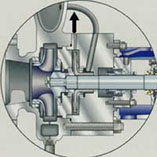Energy Primers by Bruce Murray
The economics of energy
Energy Economics and the Spin Cycle
 Calls for "energy independence" have been a part of American political discourse since the Nixon Administration. However, economic and geologic realities make it highly unlikely that the United States can end energy imports. Mark Zupan, Dean of the William E. Simon Graduate School of Business Administration at the University of Rochester, New York, discusses how to cut through the spin. Calls for "energy independence" have been a part of American political discourse since the Nixon Administration. However, economic and geologic realities make it highly unlikely that the United States can end energy imports. Mark Zupan, Dean of the William E. Simon Graduate School of Business Administration at the University of Rochester, New York, discusses how to cut through the spin.
The 'Axis of Energy'
Energy politics form a "triangle" of issues: economic efficiency and equity at the top point; energy security at another point; and the environment at the third point. Energy policy involves a tradeoff between these three elements, according to professor James L. Sweeney of Stanford University.
The Hard Truths of Energy Economics
 The world is a fossil fuel-based economy and becoming more so, not less so; and most of that fossil-fuel lies underneath unstable and hostile Middle Eastern countries. Professor Joseph P. Kalt of Harvard University says the world is set up for a "perpetual crisis” in energy. Also see Kalt's discussion on economics, "Bringing Joy to the 'Dismal Science.'" The world is a fossil fuel-based economy and becoming more so, not less so; and most of that fossil-fuel lies underneath unstable and hostile Middle Eastern countries. Professor Joseph P. Kalt of Harvard University says the world is set up for a "perpetual crisis” in energy. Also see Kalt's discussion on economics, "Bringing Joy to the 'Dismal Science.'"
Dimensions of the Energy Problem
The world is consuming oil about as fast as it can pump it out of the ground. As long as supply is tapped to the limit, prices will be high; and suppliers will have an incentive to increase investment in production. Henry Lee of Harvard University discusses the many dimensions of energy economics.
Loving and Loathing the Internal Combustion Engine
Demand for oil, like cigarettes, is considered “inelastic” — that is, demand is unresponsive to price changes in the short term. On a graph, a perfectly inelastic demand curve is vertical. Even if the price of gasoline were to double, demand would not change much in the short term. People will continue filling their tanks because they have to continue driving to work, taking their children to school, etc.
Energy, the environment and climate change
The Axes of Energy
 Figuring out how to meet the world’s demand for energy involves choosing between two complex, or dare say “inconvenient” formulas: Cost optimization based on the cheapest forms of energy available vs. the risk of pumping the resulting carbon dioxide into the atmosphere. Professor Nathan S. Lewis of the California Institute of Technology provides a macro view of energy and the environment. Figuring out how to meet the world’s demand for energy involves choosing between two complex, or dare say “inconvenient” formulas: Cost optimization based on the cheapest forms of energy available vs. the risk of pumping the resulting carbon dioxide into the atmosphere. Professor Nathan S. Lewis of the California Institute of Technology provides a macro view of energy and the environment.
Evaluating Climate Models
A major difficulty in confronting the climate change story is the sheer complexity of climate modeling. Models take into account the five major components of the earth’s climate system: the atmosphere, the hydrosphere (oceans, rivers and lakes), the cryosphere (polar regions), the land surface and the biosphere (plants and animals) — and all of the interactions between them.
Understanding climate systems
The earth's climate system consists of five major sub-systems that intereact with one another in highly complex ways. Understanding these systems is essential to understanding climate modelling.
Alternate energy
Solar power: the Holy Grail of renewable energy
 Solar power could produce an almost unlimited amount of energy if the technology were discovered. More energy from the sun hits the earth in an hour than all of the energy consumed on earth in a year. This primer reviews the many possibilities and technical limitations of harnassing solar power. Solar power could produce an almost unlimited amount of energy if the technology were discovered. More energy from the sun hits the earth in an hour than all of the energy consumed on earth in a year. This primer reviews the many possibilities and technical limitations of harnassing solar power.
The Realities of Renewable Energy
Renewable energy sources provide many intriguing possibilities but limited practical potential for meeting the world’s growing energy demand. This primer reviews wind, hydropower, geothermal, biomass and nuclear power.
On the Bumpy Road to a Hydrogen Economy
 California Governor Arnold Schwarzenegger has famously called for the building of a "hydrogen highway" to lead the nation to the environmental future. Harnessing hydrogen power presents many intriguing possibilities and also many technical challenges. California Governor Arnold Schwarzenegger has famously called for the building of a "hydrogen highway" to lead the nation to the environmental future. Harnessing hydrogen power presents many intriguing possibilities and also many technical challenges.
Energy Policy
Global Cooling in the Golden State
California is one of 34 states that have enacted legislation mandating a reduction in greenhouse gas emissions. The California Global Warming Solutions Act of 2006 (Assembly Bill 32) mandates that the state reduce its greenhouse gas emissions to 1990 levels by 2020. This, despite the fact that California will be well on its way toward re-doubling its population by then.
|


 Calls for "energy independence" have been a part of American political discourse since the Nixon Administration. However, economic and geologic realities make it highly unlikely that the United States can end energy imports.
Calls for "energy independence" have been a part of American political discourse since the Nixon Administration. However, economic and geologic realities make it highly unlikely that the United States can end energy imports.  The world is a fossil fuel-based economy and becoming more so, not less so; and most of that fossil-fuel lies underneath unstable and hostile Middle Eastern countries. Professor
The world is a fossil fuel-based economy and becoming more so, not less so; and most of that fossil-fuel lies underneath unstable and hostile Middle Eastern countries. Professor  Figuring out how to meet the world’s demand for energy involves choosing between two complex, or dare say “inconvenient” formulas: Cost optimization based on the cheapest forms of energy available vs. the risk of pumping the resulting carbon dioxide into the atmosphere. Professor
Figuring out how to meet the world’s demand for energy involves choosing between two complex, or dare say “inconvenient” formulas: Cost optimization based on the cheapest forms of energy available vs. the risk of pumping the resulting carbon dioxide into the atmosphere. Professor  Solar power could produce an almost unlimited amount of energy if the technology were discovered. More energy from the sun hits the earth in an hour than all of the energy consumed on earth in a year. This primer reviews the many possibilities and technical limitations of harnassing solar power.
Solar power could produce an almost unlimited amount of energy if the technology were discovered. More energy from the sun hits the earth in an hour than all of the energy consumed on earth in a year. This primer reviews the many possibilities and technical limitations of harnassing solar power.  California Governor Arnold Schwarzenegger has famously called for the building of a
California Governor Arnold Schwarzenegger has famously called for the building of a